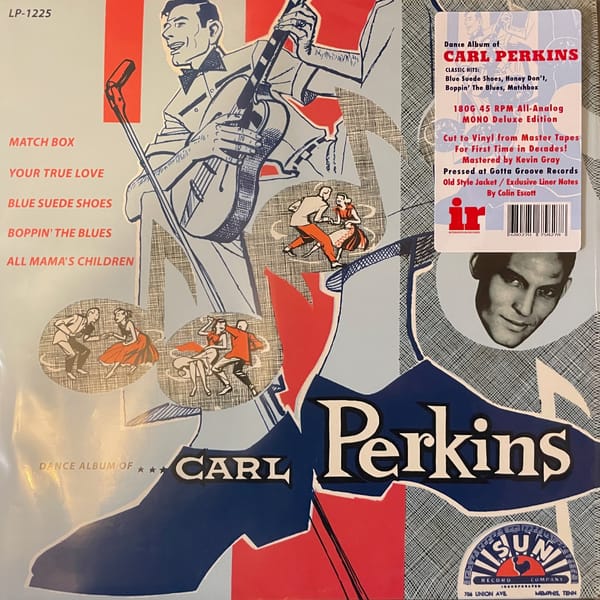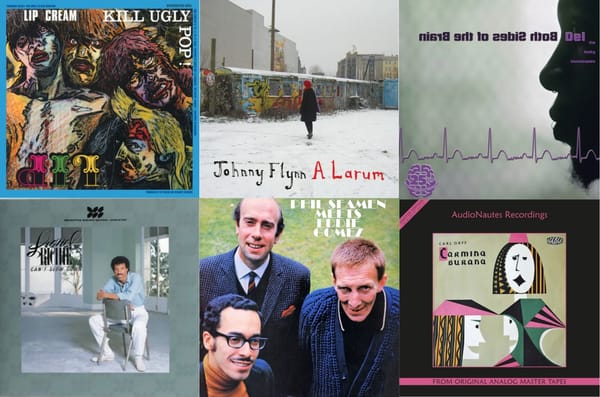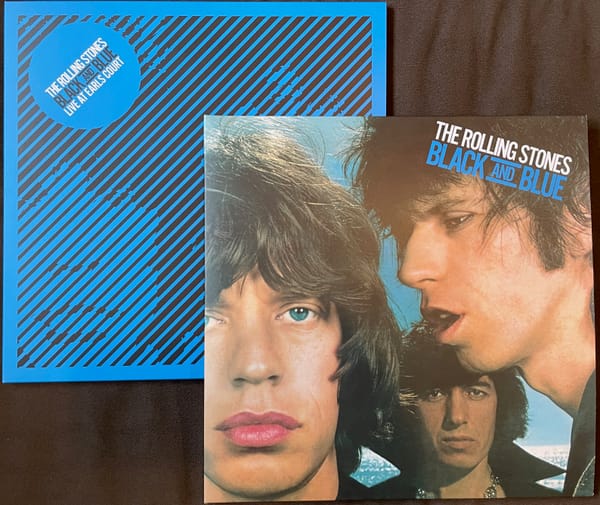Reviews: Neil Young and Rumah Sakit
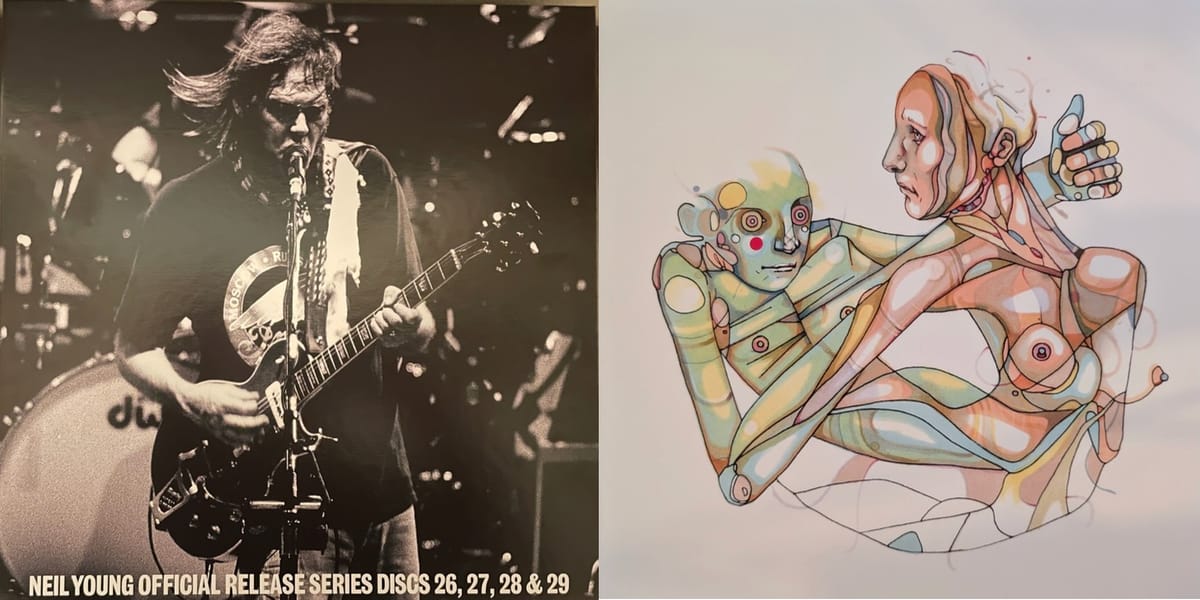
Vinyl reviews for the sixth Official Release Series box and Rumah Sakit 25.
We’ll get right into it today, with two vinyl reviews for you. I went long on the new Neil Young box set, which includes some of his most difficult-to-find albums back on vinyl. And Bob’s got a look at the 25th-anniversary reissue of the debut album by San Francisco instrumental band Rumah Sakit.
Thanks once again to all our subscribers, who make this newsletter possible. We really appreciate you coming aboard with us. Coming up later this week, we’ll have a comprehensive rundown of Friday’s new reissues, as well as the final installment in our Rhino Rocktober series, featuring the Stooges, Rush, the Faces, and (once again) Warren Zevon. So stick around!
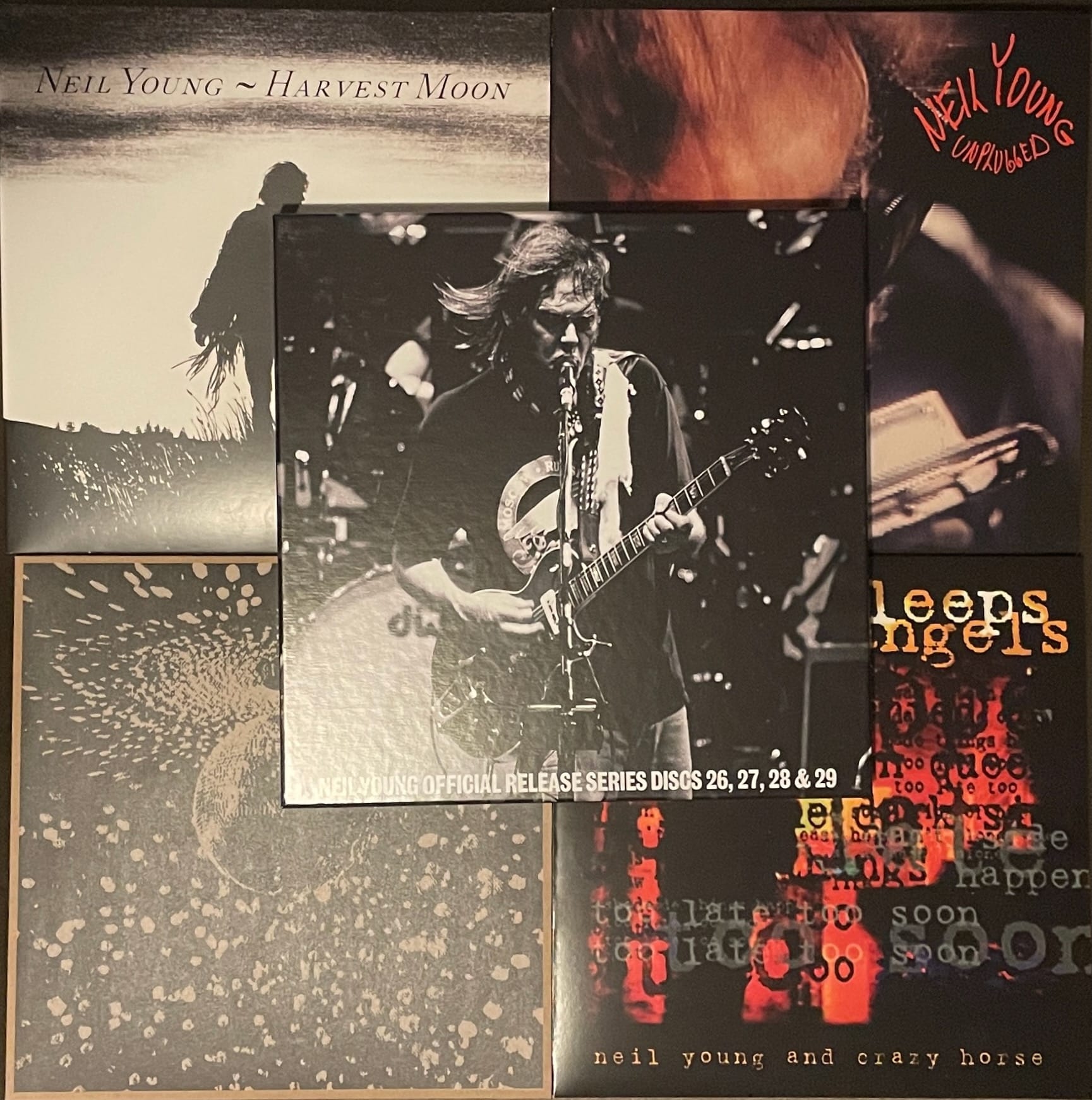
Neil Young: Official Release Series Discs 26, 27, 28 & 29 [Reprise]
Review by Ned Lannamann
Neil Young is no stranger to boxing up his past. Aside from the massive multi-disc Archives sets he’s been unleashing every few years, the Canadian-born songwriter has also been re-releasing his original albums in batches of four or so, with Official Release Series box sets sporadically appearing on vinyl and CD. The vinyl for all of these sets thus far has been excellent-sounding, with meticulous pressings cut directly from the original analog tapes. And now the sixth volume of that series is in our greedy hands, bearing the ungainly but numerically accurate title Official Release Series Discs 26, 27, 28 & 29.
The vinyl version of this new ORS is simultaneously the most anticipated of these album boxes to date and the least necessary. The four ’90s albums contained herein—Harvest Moon, Unplugged, Sleeps with Angels, and Mirror Ball—are some of Young’s best and most popular works. And the albums have been very difficult to track down on vinyl; apart from Harvest Moon, none of them have been reissued on vinyl since their initial releases during the CD era, meaning that original vinyl copies were scarce to begin with. However, three of the four albums were recorded digitally and mixed down to 16 bit/44.1kHz digital—the standard resolution for CD—while the fourth, Mirror Ball, was recorded on analog tape but then mixed down to the very slightly higher 20 bit/44.1kHz for HDCD encoding. This means that there are no complete analog masters for these albums and not even a meaningfully high-resolution digital version. Cutting them to vinyl would probably not lead to much of an improvement over CD, which is likely the reason Young resisted reissuing most of them on his (and our) preferred format until now.
And yet the market wants what the market wants: these terrific albums back on hot wax. It’s not something Young could have avoided, either, if he wanted his Official Release Series to continue on vinyl (although so far he has conveniently sidestepped reissuing his mid-’80s Geffen albums, but that may be a contractual situation). To make the proposition more enticing, Young and his audio guy, John Hanlon, dug into the Mirror Ball masters and discovered that much of the album was in fact actually mixed to analog. They decided to make new analog mixes of the four songs that only had digital mixes, so that all of Mirror Ball could be cut directly from analog tape. However, the situation turned out to be a little more complicated than that—we seem to have an almost entirely new Mirror Ball on our hands, as I’ll attempt to explain shortly.
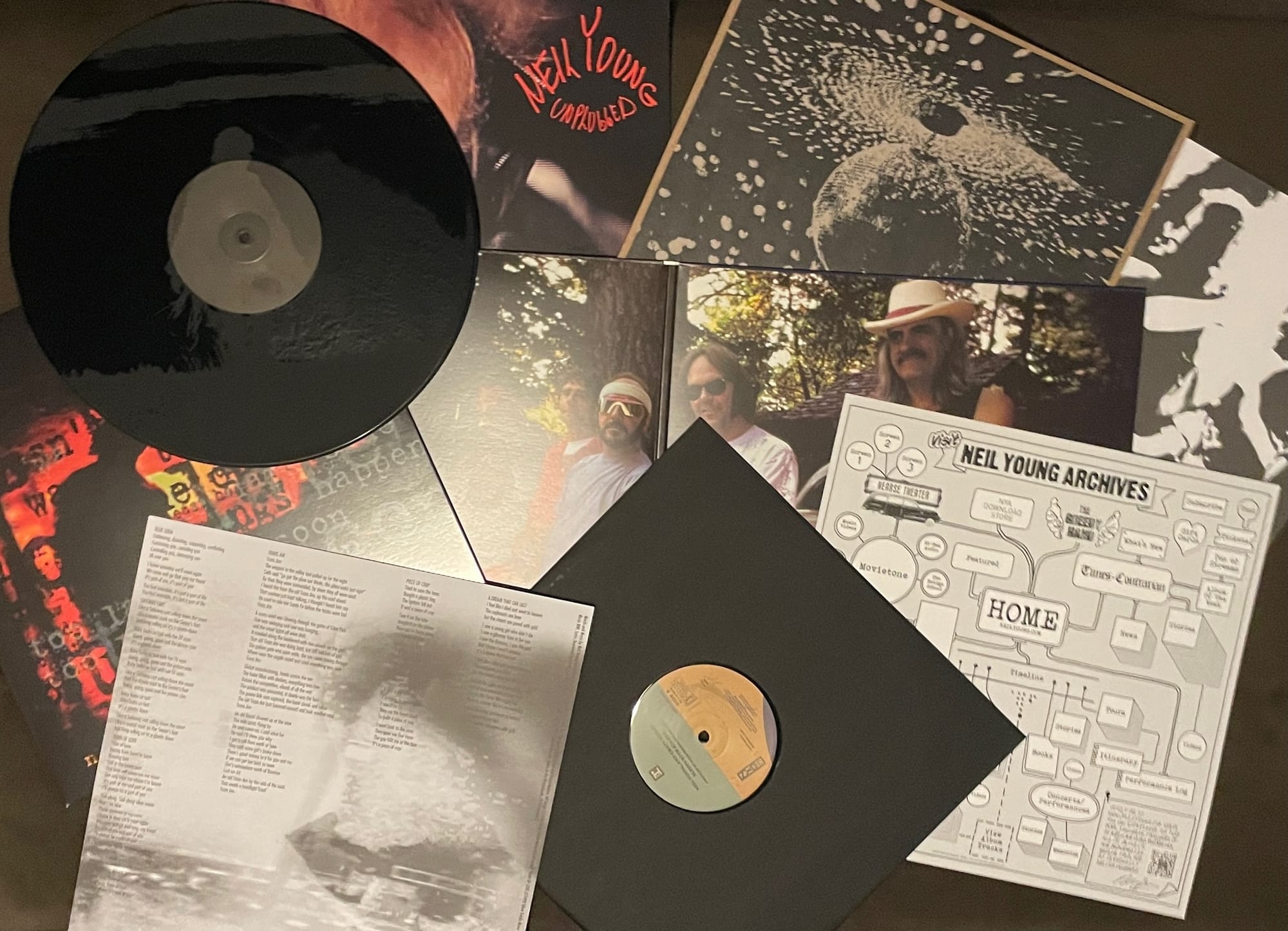
The first album in the box, 1992’s Harvest Moon, is Young’s gentlest album, and its title track became Young’s best-loved song of the ’90s. It was written and recorded in the aftermath of the cacophonous Ragged Glory tour and resultant Weld live album, from which Young suffered tinnitus and thus needed to find a way to turn the volume way down. Pitched as a sequel to Harvest and played by many of the same musicians, Harvest Moon focuses on that 1972 album’s acoustic elements, eschewing its electric detours and orchestral bombast—arranger Jack Nitzsche’s presence here results in the glidingly serene “Such a Woman,” a very far cry from the overwrought “A Man Needs a Maid”—in favor of a chill-as-hell backwoods milieu and some of Young’s most gorgeous, affecting songs.
Naturally, an ensuing appearance on MTV Unplugged made perfect sense, and Reprise Records could probably scarcely believe their luck when they had a Neil Young Unplugged album to release in 1993. While successful enough at the time, it fell shy of the blockbuster status that Eric Clapton’s Unplugged album had attained the previous year, and even today it’s among the least essential of Young’s ’90s recordings. It was Young’s second attempt to film an Unplugged set—the first run-through was a total fiasco, and he was reportedly unhappy during this recording as well. This isn’t really apparent on the album, though, as Young sounds as serene and mystic as he ever has, in full command of the crowd during the solo first half, playing tunes like “The Old Laughing Lady,” “Pocahontas,” and a previously unreleased 1976 outtake, “Stringman,” before bringing out the band to run through some more hits and Harvest Moon material. It’s never been a record I rated highly, but I found it almost overwhelmingly pleasant to revisit on a Sunday morning, with a top-notch setlist and a beautiful sparseness to the sound that works wonderfully well on vinyl. The crowd’s mixed a little too loud, but what can you do?
The box’s real prize is 1994’s Sleeps with Angels, which Young recorded with longtime band Crazy Horse. A critical and fan favorite, Sleeps nevertheless remains one of Young’s least traversed records, with almost none of its songs played live with any regularity and its numerous stylistic furrows located in areas that Young and Crazy Horse never plowed again. The thunderous, nervy title track was written in response to Kurt Cobain’s suicide note, which quoted Young’s lyrics, but the underlying grief of the album actually gravitates around “Driveby,” a song that reflects on the death of a family acquaintance killed in a car. The centerpiece is “Change Your Mind,” a loose 15-minute jam that harkens back to previous Crazy Horse epics like “Cowgirl in the Sand” and “Cortez the Killer” but remaining more slippery and elusive than the usual Horse barn-burners. It’s surrounded by musical detours, like the improvised “Blue Eden,” which finds Young singing scraps of lyrics from other album tracks over an unnervingly spooky blues, or the hymn-like meditation of “A Dream That Can Last,” or the beautiful twinned tunes of “Western Hero” and “Train of Love,” which feature identical melodies with entirely different sets of lyrics. It’s a mysterious, raw, unsettling album with occasional slices of hope, beauty, and gratitude that doesn’t sound like anything else Young ever recorded.
Then there’s Mirror Ball, the 1995 album Young recorded in Seattle with Pearl Jam. It’s not merely Young’s most raucous record since Ragged Glory—with the younger band behind him, it’s easily the briskest, punchiest LP he ever released. The songs are magnificent: “I’m the Ocean” is a relentless stream-of-consciousness surf across various dimensions via four repeated chords; “Peace and Love” reframes clichéd ideals to make them vital for 1995; and “Scenery” is an epic that Crazy Horse could have easily turned into a transcendent lope, but in Pearl Jam’s hands it turns positively volcanic. There’s not a dud on the album.
So what’s new about the Mirror Ball in this vinyl box set? The four songs John Hanlon remixed are “I’m the Ocean,” “Big Green Country,” “Truth Be Known,” and “Throw Your Hatred Down,” and they sound very, very subtly different from the originals. Young’s vocals were famously buried on Mirror Ball, and Hanlon has extracted them for more legibility and nuance; the drums have a slightly different character, and the three-guitar morass of Young, Stone Gossard, and Mike McCready takes on a minutely different grain and luster. But surprisingly, there are noticeable differences beyond those four songs. “Song X” and “Act of Love” are presented in alternate mixes as well, with certain vocal refrains that are either absent (“Song X” is missing its first two choruses of “hey-ho, away we go”) or appear early (the titular refrain for “Act of Love” comes in one verse sooner than it used to). And “Peace of Love” now bears an extended ending, with more than a minute and a half of abstract guitar feedback that’s never been heard before. I think the rest of “Peace and Love” might be a different mix, too, but I can’t be positive about that, nor can I say for sure whether anything else in the remaining tracks has changed. “Downtown” sounds the same to my ears, but “Scenery” is such a thick, dense stew that subtle mix changes would be difficult to pinpoint. The two remaining songs, “What Happened Yesterday” and “Fallen Angel,” feature just Young’s voice and pump organ, so any minor mixing shifts to those would be negligible.
In short, this Mirror Ball is not exactly the Mirror Ball you grew up with. The differences—in both the new Hanlon remixes and in the unadvertised alternate mixes, which if I had to guess were made by producer Brendan O’Brien during the 1995 sessions and left forgotten on the unused analog assembly reels—may jump out to the devoted who know this album back to front. But I think most people will either not notice them or be more than satisfied with their richness and fullness. Cutting from analog slightly softens the heavy electric tone of the three-guitar ensemble and marginally strips some of the power out of Jack Irons’s propulsive drums. After spending entirely too much time thinking about it, I’m currently of the mind that the original Mirror Ball’s thick, chewy sound has a bit more fire to it, but the difference is so small that I expect I could just as easily find things I like better about the 2025 version in a future listen.
I should add that the other three albums, all cut from 16/44.1 digital files, sound fabulous. Unplugged sounds better to me on vinyl than it ever did on CD, and Sleeps with Angels features a diversity of sound that the vinyl presentation meets on every level, from the dense clamor of “Piece of Crap” to the disquieting ambience of “Safeway Cart.” Some songs on Harvest Moon have a cool, smooth sheen that vinyl can’t quite penetrate, but the album’s clarity and precision sounds awfully pleasant nevertheless. Harvest Moon (52 minutes) and Unplugged (66 minutes!) are thankfully expanded from their initial single-disc formats to sprawl across three sides, with an etching on the fourth side; Sleeps with Angels and Mirror Ball both replicate their original four-sided presentations.
All the discs are from new cuts by Chris Bellman of Bernie Grundman Mastering, except for Harvest Moon, which reuses two cuts Bellman made previously: one for 2017’s Record Store Day reissue (with the number “563181” in the deadwax), and one for a clear-vinyl cut released in 2023 (with “093624910787” in the deadwax). [Nerd tangent: It appears that plates from these two cuts are being mix-and-matched throughout different copies of the box. My copy has the 2017 plates on Sides 1 and 3, and the 2023 plate for Side 2. However, I have heard that another copy has the 2017 plates for Sides 1 and 2 and the 2023 plates for Side 3, while the copy entered into Discogs appears to have the 2017 plate for Side 1 only, and the 2023 plates for Sides 2 and 3.] The 2017 cut has a reputation for sibilance during “Unknown Legend” and “Harvest Moon,” which I did not notice at all in this pressing; however, I did pick up on some sibilance during “Natural Beauty.”
The other new cuts sound great, with my only complaint being that the lead-in grooves for Mirror Ball are much too tight. The pressings were done at Record Industry in the Netherlands, and they are generally good, with superbly silent vinyl and no non-fill whatsoever. However, all eight discs in my box were very, very slightly dished—nothing to cause alarm, but something to be aware of. Furthermore, my Side 2 of Sleeps with Angels was just a little bit off-center, which I started to notice during Young’s sustained guitar tones during the jam’s final minutes. And lastly, my Side 1 of Unplugged had a quiet but irritating repeating tick at the end of “Stringman,” which I will try to eliminate with some cleaning. There’s nothing here I’d consider a deal-breaker, but pickier vinyl buyers should take note.
The packaging aims to replicate the original releases as closely as possible, although this Harvest Moon’s gatefold originated in the 2017 and 2023 represses. The other three albums stick two discs inside a chubby single jacket—no gatefolds. Mirror Ball comes inside a rough, brown, Kraft card jacket (as per the original); Sleeps with Angel’s cover art looks atrociously low-res (as per the original, I guess) and the vinyl package of Sleeps is unfortunately missing the individual musician credits that appeared on the actual physical CD itself. All the discs come inside die-cut black paper sleeves, earning demerits for not being polylined, and each album gets an insert with lyrics; Unplugged’s is meant to replicate the original one-disc version’s lone inner sleeve, even though this new and improved version is two discs. Some folks have reported their copies are missing inserts, so take note of yours and make sure you’ve got all four. The only thing extra inside the numbered box, with lift-off lid, is a card with the now-familiar diagram of the Neil Young Archives website.
With a gently tweaked Mirror Ball and an Unplugged that is no longer jammed onto overlong sides of vinyl, this sixth installment of the Official Release Series justifies its existence. But the real win here is having all these albums back on vinyl, particularly Sleeps with Angels. As is his way, Young has already moved well past this particular retrospective, with talks of a tour next year, an archival Pearl Jam live set in the works, and an expanded 50th anniversary reissue of Tonight’s the Night coming out on November 28. (Equally exciting is the 1973 live show that was just posted on his Archives website, an audience-recorded cassette that was discovered in a Hamilton record store, featuring a concert recorded at Hamilton’s McMaster University during the Tonight’s the Night tour.) Being a student of Young’s history continues to be overwhelming but immensely fulfilling—and now an important chunk of that history can reclaim some deserved vinyl shelf space.
Official Release Series Discs 26, 27, 28 & 29 | Reprise 8-LP 33 RPM • Harvest Moon, Unplugged & Sleeps with Angels cut to lacquer from 16/44.1 digital by Chris Bellman of Bernie Grundman Mastering • Mirror Ball cut to lacquer from analog tape by Bellman with assistance from John Hanlon • pressed at Record Industry • black vinyl
Listening equipment
Table: Technics SL-1200MK2
Cart: Audio-Technica VM540ML
Amp: Luxman L-509X
Speakers: ADS L980
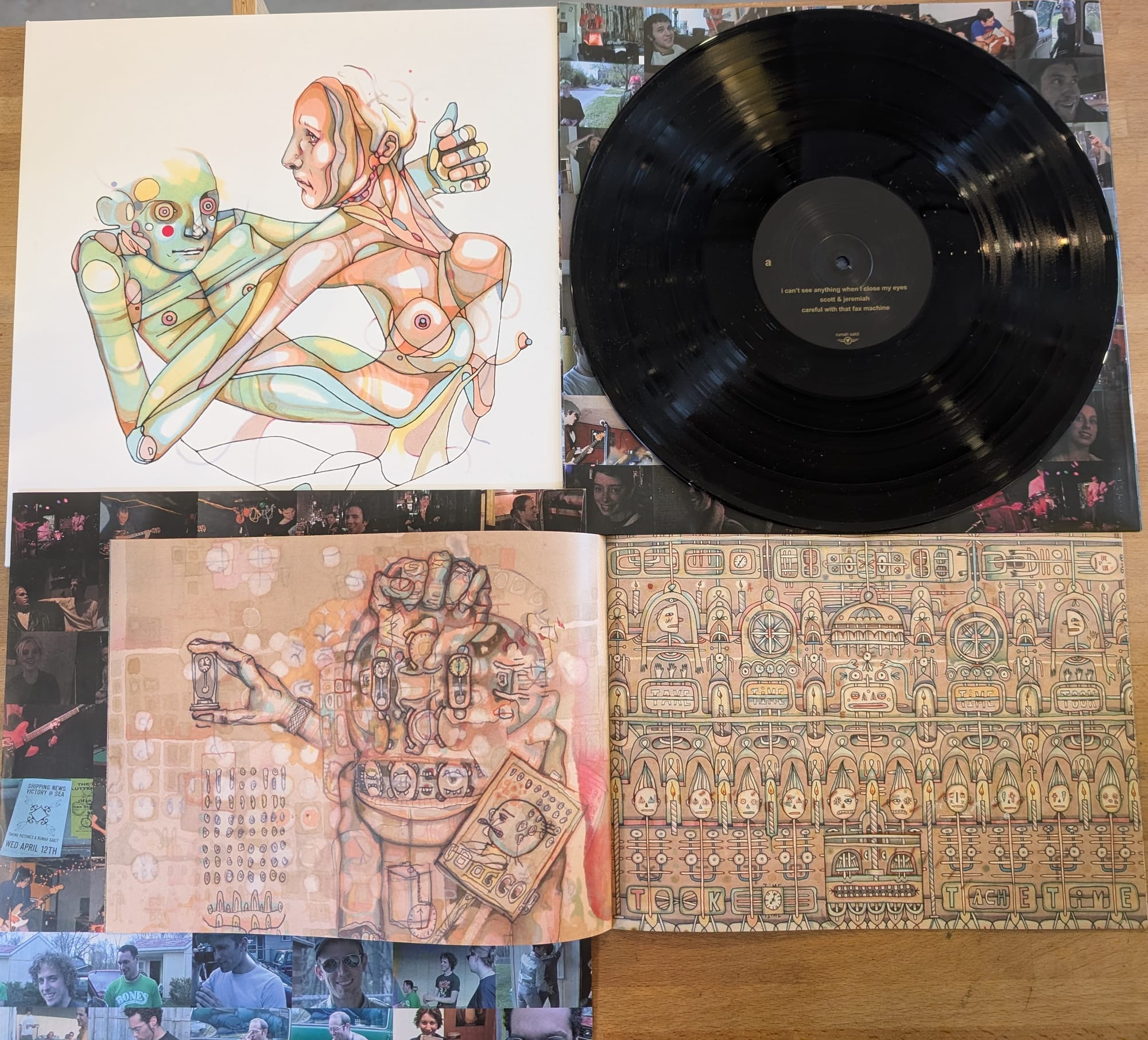
Rumah Sakit: Rumah Sakit 25 [Temporary Residence Limited]
Review by Robert Ham
Of all the instrumental post-rock groups that were stirred to life in the wake of milestone albums like Slint’s Spiderland and Don Caballero’s For Respect, Rumah Sakit has aged better than most. The Bay Area quartet held true to all the signifiers of their chosen genre—instrumental dexterity, time signatures in the double digits, musical nods to forebears like King Crimson and Rush, goofy-ass song titles (“Careful With That Fax Machine,” “Sausage Full of Secrets”)—but unlike many of their contemporaries, they allowed for moments of restraint and delicacy in their work as well as some good ol’ human error.
In the credits for Rumah Sakit 25, a gorgeous reissue of the group’s 2000 debut, the standout detail is that the album was “recorded with an ambient philosophy, no overdubs and no ‘tricks.’ This album contains stereo phasing elements executed by mic placement and the room’s natural dynamic.” The “room” in question was the Music Annex, a studio in Menlo Park, California, where the band posted up in 1999 with engineers Jay and Ian Pellicci to knock out the six songs that made up their first full-length. The band played together at the same time, laying down the tracks in as few takes as possible. It’s a credit to the band that it comes off as well as it does: loud, compelling, nearly flawless, and as close as one can get to being in the room where it happened.
Full credit, though, is due to Bob Weston, the longtime recording and mastering engineer who remastered the audio for this release. It certainly helped that he was familiar with the band. Weston worked with the band in the studio on three tracks originally issued in 2001 as part of an EP for Temporary Residence’s Travels in Constants mail-order CD series. Those songs have been pressed to vinyl for the first time on the bonus disc for this reissue. The package also includes some new artwork—and an additional book of paintings—by friend of the band Jeremiah Maddock.
With Weston’s sure hands at the controls, the original album material has the precision and punch necessary to give these knotty compositions maximum sonic impact. Jeff Shannon’s drums, in particular, burst through the mix like controlled explosions, and each pluck and strum of John Baez and Mitch Cheney’s guitars tangle together in beautiful braids or tightly wrenched knots. While still dynamic and crisp, there is a perceptible shift in tone when moving to disc two. That’s to be expected, I’m sure, as the band and Weston were working in a different studio (Tiny Telephone Recording in San Francisco) with a different “natural dynamic.” But that slight step down, sonically speaking, takes nothing away from the commanding presence that the music maintains. The more I spun these discs, the deeper it held my attention. I have little doubt that they’ll do the same for you.
Rumah Sakit 25 | Temporary Residence Ltd. 2-LP • mastered and cut to lacquer from unknown source by Bob Weston • pressed at Optimal • black vinyl
Listening equipment
Table: Cambridge Audio Alva ST
Cart: Audio-Technica VAT-VM95E
Amp: Sansui 9090
Speakers: Electro Voice TS8-2

